The neutron is a particle with zero charge still it has a non-zero magnetic moment with z-component 9.66×10−27A−m2. This can be explained by the internal structure of the neutron. The evidence indicates that a neutron is composed of three fundamental particles calleed quarks : an up (u) quark, of charge +2e3, and two down (d) quarks, each of change −e3. The combinations of the three quarks prodcues a net charge of 2e3−e3−e3=0.
_E01_152_Q01.png)
If the quarks are in motion they can produce a non-zero magnetic moment. As a very simple model, suppose the u quark moves in a counter clockwise circular path and the d quarks move in a clockwise circular path, all of the radius r and all with the same speed v see figure.
Determine the magnitude of the magnetic moment due of the circular u quark :-Solution in Gujrati
evr3πr
2evr3
4evr3
evr
The correct Answer is:A
Mu=evr3
Topper's Solved these Questions
- SIMPLE HARMONIC MOTIONBOOK - ALLEN CHAPTER - SIMPLE HARMONIC MOTIONEXERCISE - Exercise - 30
2 Videos
- SIMPLE HARMONIC MOTIONBOOK - ALLEN CHAPTER - SIMPLE HARMONIC MOTIONEXERCISE - Exercise - 31
2 Videos
- SIMPLE HARMONIC MOTIONBOOK - ALLEN CHAPTER - SIMPLE HARMONIC MOTIONEXERCISE - Exercise - 28
2 Videos
- RACEBOOK - ALLEN CHAPTER - RACEEXERCISE - Basic Maths (Wave Motion & Dopplers Effect) (Stationary waves & doppler effect, beats)
25 Videos
- TEST PAPERBOOK - ALLEN CHAPTER - TEST PAPEREXERCISE - PHYSICS
4 Videos
Similar Questions
When the atomic number Z of the nucleus increases
View SolutionThe decay constant of a radioactive substance is 0.173(years)−1. Therefore:
View SolutionIn a Coolidege tube experiment, the minimum wavelength of the continuouse X-ray spectrum is equal to 66.3 om . Then
View SolutionThe frequency of a radar is 780 MHz. After getting reflected from an approaching aeroplane, the apparent frequency is more than the actual frequency by 2.6 kHz. The aeroplane has a speed of
View SolutionChoose the correct statement:
View SolutionThe neutron is a particle with zero charge still it has a non-zero magnetic moment with z-component 9.66 xx 10^(-27) A-m^(2) . This can be explained by the internal structure of the neutron. The evidence indicates that a neutron is composed of three fundamental particles calleed quarks : an "up" (u) quark, of charge + (2e)/(3) , and two "down" (d) quarks, each of change - (e)/(3) . The combinations of the three quarks prodcues a net charge of (2e)/(3) - e/3 - e/3 = 0 . If the quarks are in motion they can produce a non-zero magnetic moment. As a very simple model, suppose the u quark moves in a counter clockwise circular path and the d quarks move in a clockwise circular path, all of the radius r and all with the same speed v see figure. The current due to the circular motion of the u quark :-
View SolutionThe neutron is a particle with zero charge still it has a non-zero magnetic moment with z-component 9.66 xx 10^(-27) A-m^(2) . This can be explained by the internal structure of the neutron. The evidence indicates that a neutron is composed of three fundamental particles calleed quarks : an "up" (u) quark, of charge + (2e)/(3) , and two "down" (d) quarks, each of change - (e)/(3) . The combinations of the three quarks prodcues a net charge of (2e)/(3) - e/3 - e/3 = 0 . If the quarks are in motion they can produce a non-zero magnetic moment. As a very simple model, suppose the u quark moves in a counter clockwise circular path and the d quarks move in a clockwise circular path, all of the radius r and all with the same speed v see figure. Determine the magnitude of the magnetic moment due of the circular u quark :-
View SolutionThe neutron is a particle with zero charge still it has a non-zero magnetic moment with z-component 9.66×10−27A−m2. This can be explained by the internal structure of the neutron. The evidence indicates that a neutron is composed of three fundamental particles calleed quarks : an up (u) quark, of charge +2e3, and two down (d) quarks, each of change −e3. The combinations of the three quarks prodcues a net charge of 2e3−e3−e3=0.
_E01_153_Q01.png)
If the quarks are in motion they can produce a non-zero magnetic moment. As a very simple model, suppose the u quark moves in a counter clockwise circular path and the d quarks move in a clockwise circular path, all of the radius r and all with the same speed v see figure.
Determine the magnitude of the three-quark system :-
View SolutionThe neutron is a particle with zero charge still it has a non-zero magnetic moment with z-component 9.66 xx 10^(-27) A-m^(2) . This can be explained by the internal structure of the neutron. The evidence indicates that a neutron is composed of three fundamental particles calleed quarks : an "up" (u) quark, of charge + (2e)/(3) , and two "down" (d) quarks, each of change - (e)/(3) . The combinations of the three quarks prodcues a net charge of (2e)/(3) - e/3 - e/3 = 0 . If the quarks are in motion they can produce a non-zero magnetic moment. As a very simple model, suppose the u quark moves in a counter clockwise circular path and the d quarks move in a clockwise circular path, all of the radius r and all with the same speed v see figure. If all Quarks start moving in the same direction then what will be the magnetic moment of the neutron :-
View Solutionनाभिक की संरचना प्रोटॉन तथा न्यूट्रॉन के कारण होती हैं , जहाँ प्रोटॉन धनावेशित कण हैं जबकि न्यूट्रॉन अनावेशित होता हैं । न्यूट्रॉन के क्वार्क मॉडल ( quark model ) के आधार पर इसका नेट आवेश शून्य रहने पर भी इसे अशून्य (nonzero) चुबंकीय आघूर्ण प्राप्त हैं जिसका z-घटक 9.66×10−27A−m2 होता हैं । इस संकल्पना की व्याख्या न्यूट्रॉन के आंतरिक बनावट के आधार पर की जा सकती हैं । न्यूट्रॉन की सरंचना तीन प्रकार के मौलिक कणों ( fundamental particles) व्दारा होती हैं जिन्हें क्वार्क (quark) कहा जाता हैंः
एक अप क्वार्क ( up quark ) , संकेत u , आवेश + 2e3
दो डाउन क्वार्क ( down quark ) , संकेत d , प्रत्येक पर आवेश - e3
तीन प्रकार के कणों के सम्मिलित प्रभाव से न्यूट्रॉन का नेट आवेश = 2e3−e3−e3 = शून्य । यदि ये क्वार्क गतिमान हो तब इनके व्दारा उत्पन्न चुंबकीय आघूर्ण अशून्य हो सकता हैं । चित्र में प्रदर्शित सरल मॉडल में u - क्वार्क r त्रिज्या v से वामावर्त दिशा में (anticlockwise) घूम रहा हैं तथा दोनों d - क्वार्क उसी वृतीय पथ पर समान वेग v से दक्षिणावर्त दिशा में (clockwise) घूम रहे हैं ।
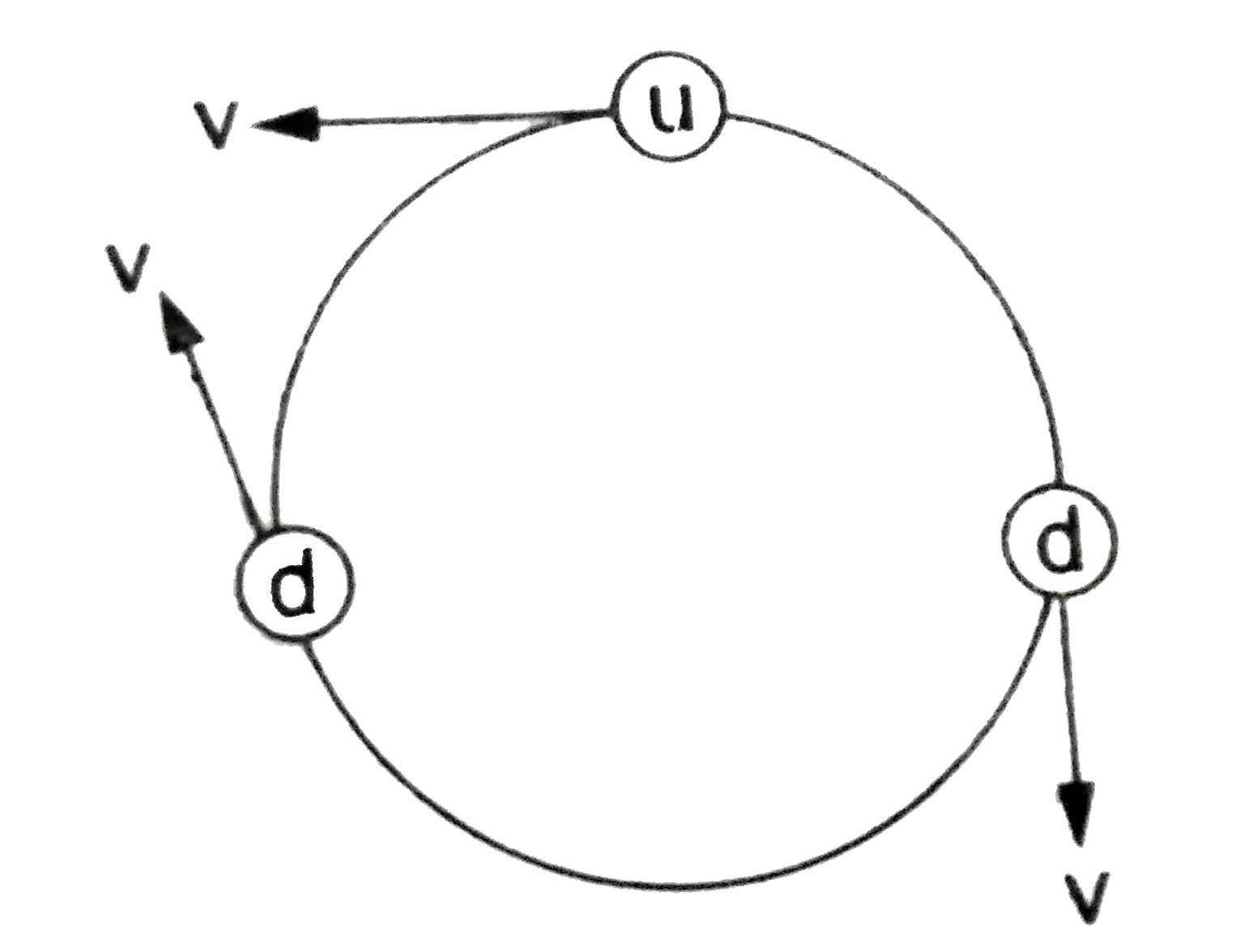
u - क्वार्क की एकसमान वृत्तीय गति के कारण तुल्य विद्युत - धारा हैं
View Solutionनाभिक की संरचना प्रोटॉन तथा न्यूट्रॉन के कारण होती हैं , जहाँ प्रोटॉन धनावेशित कण हैं जबकि न्यूट्रॉन अनावेशित होता हैं । न्यूट्रॉन के क्वार्क मॉडल ( quark model ) के आधार पर इसका नेट आवेश शून्य रहने पर भी इसे अशून्य (nonzero) चुबंकीय आघूर्ण प्राप्त हैं जिसका z-घटक 9.66×10−27A−m2 होता हैं । इस संकल्पना की व्याख्या न्यूट्रॉन के आंतरिक बनावट के आधार पर की जा सकती हैं । न्यूट्रॉन की सरंचना तीन प्रकार के मौलिक कणों ( fundamental particles) व्दारा होती हैं जिन्हें क्वार्क (quark) कहा जाता हैंः
एक अप क्वार्क ( up quark ) , संकेत u , आवेश + 2e3
दो डाउन क्वार्क ( down quark ) , संकेत d , प्रत्येक पर आवेश - e3
तीन प्रकार के कणों के सम्मिलित प्रभाव से न्यूट्रॉन का नेट आवेश = 2e3−e3−e3 = शून्य । यदि ये क्वार्क गतिमान हो तब इनके व्दारा उत्पन्न चुंबकीय आघूर्ण अशून्य हो सकता हैं । चित्र में प्रदर्शित सरल मॉडल में u - क्वार्क r त्रिज्या v से वामावर्त दिशा में (anticlockwise) घूम रहा हैं तथा दोनों d - क्वार्क उसी वृतीय पथ पर समान वेग v से दक्षिणावर्त दिशा में (clockwise) घूम रहे हैं ।
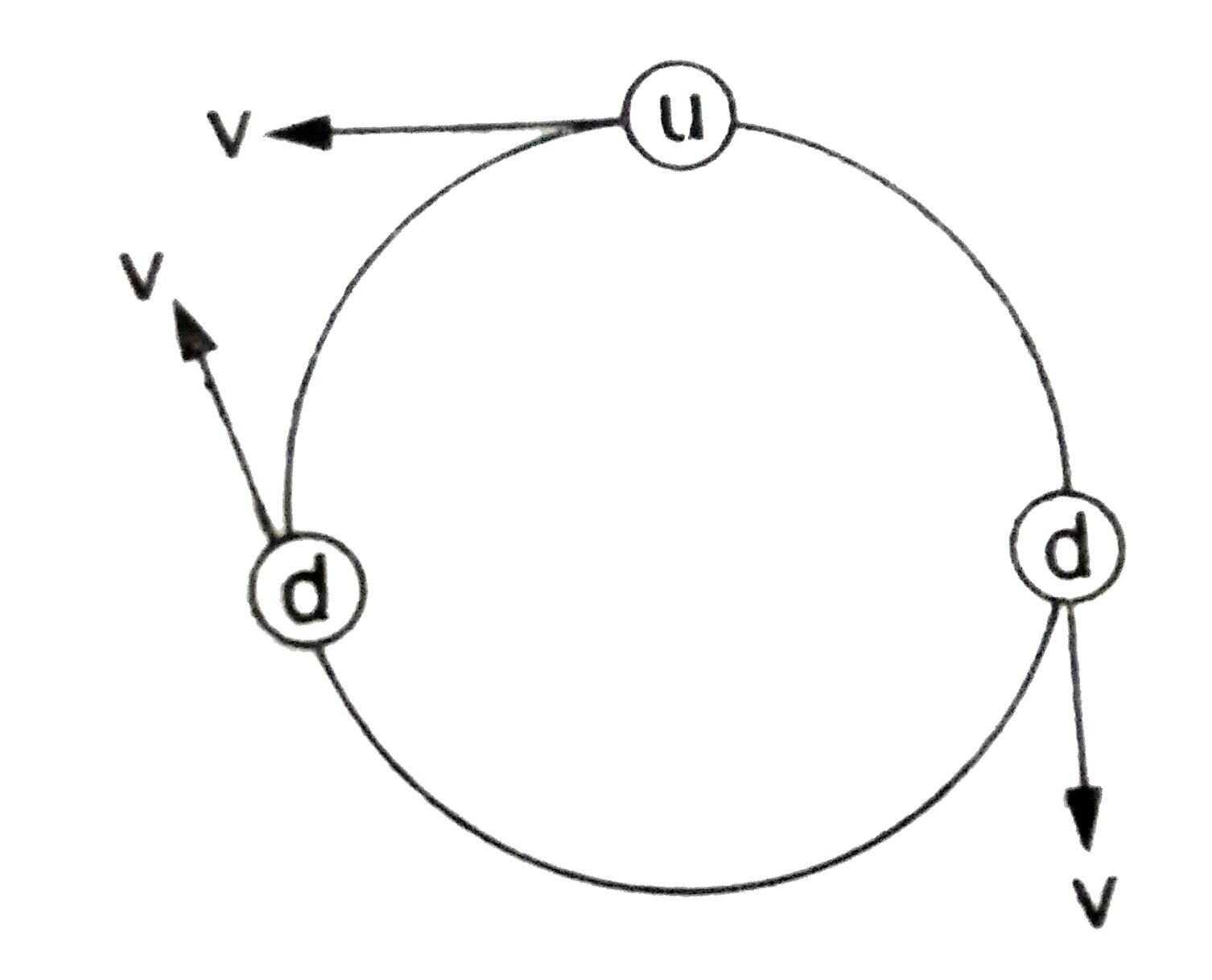
तीनों क्वार्क के निकाय के सम्मिलित प्रभाव के कारण नेट चुंबकीय आपूर्ण का परिणाम
View Solutionनाभिक की संरचना प्रोटॉन तथा न्यूट्रॉन के कारण होती हैं , जहाँ प्रोटॉन धनावेशित कण हैं जबकि न्यूट्रॉन अनावेशित होता हैं । न्यूट्रॉन के क्वार्क मॉडल ( quark model ) के आधार पर इसका नेट आवेश शून्य रहने पर भी इसे अशून्य (nonzero) चुबंकीय आघूर्ण प्राप्त हैं जिसका z-घटक 9.66×10−27A−m2 होता हैं । इस संकल्पना की व्याख्या न्यूट्रॉन के आंतरिक बनावट के आधार पर की जा सकती हैं । न्यूट्रॉन की सरंचना तीन प्रकार के मौलिक कणों ( fundamental particles) व्दारा होती हैं जिन्हें क्वार्क (quark) कहा जाता हैंः
एक अप क्वार्क ( up quark ) , संकेत u , आवेश + 2e3
दो डाउन क्वार्क ( down quark ) , संकेत d , प्रत्येक पर आवेश - e3
तीन प्रकार के कणों के सम्मिलित प्रभाव से न्यूट्रॉन का नेट आवेश = 2e3−e3−e3 = शून्य । यदि ये क्वार्क गतिमान हो तब इनके व्दारा उत्पन्न चुंबकीय आघूर्ण अशून्य हो सकता हैं । चित्र में प्रदर्शित सरल मॉडल में u - क्वार्क r त्रिज्या v से वामावर्त दिशा में (anticlockwise) घूम रहा हैं तथा दोनों d - क्वार्क उसी वृतीय पथ पर समान वेग v से दक्षिणावर्त दिशा में (clockwise) घूम रहे हैं ।
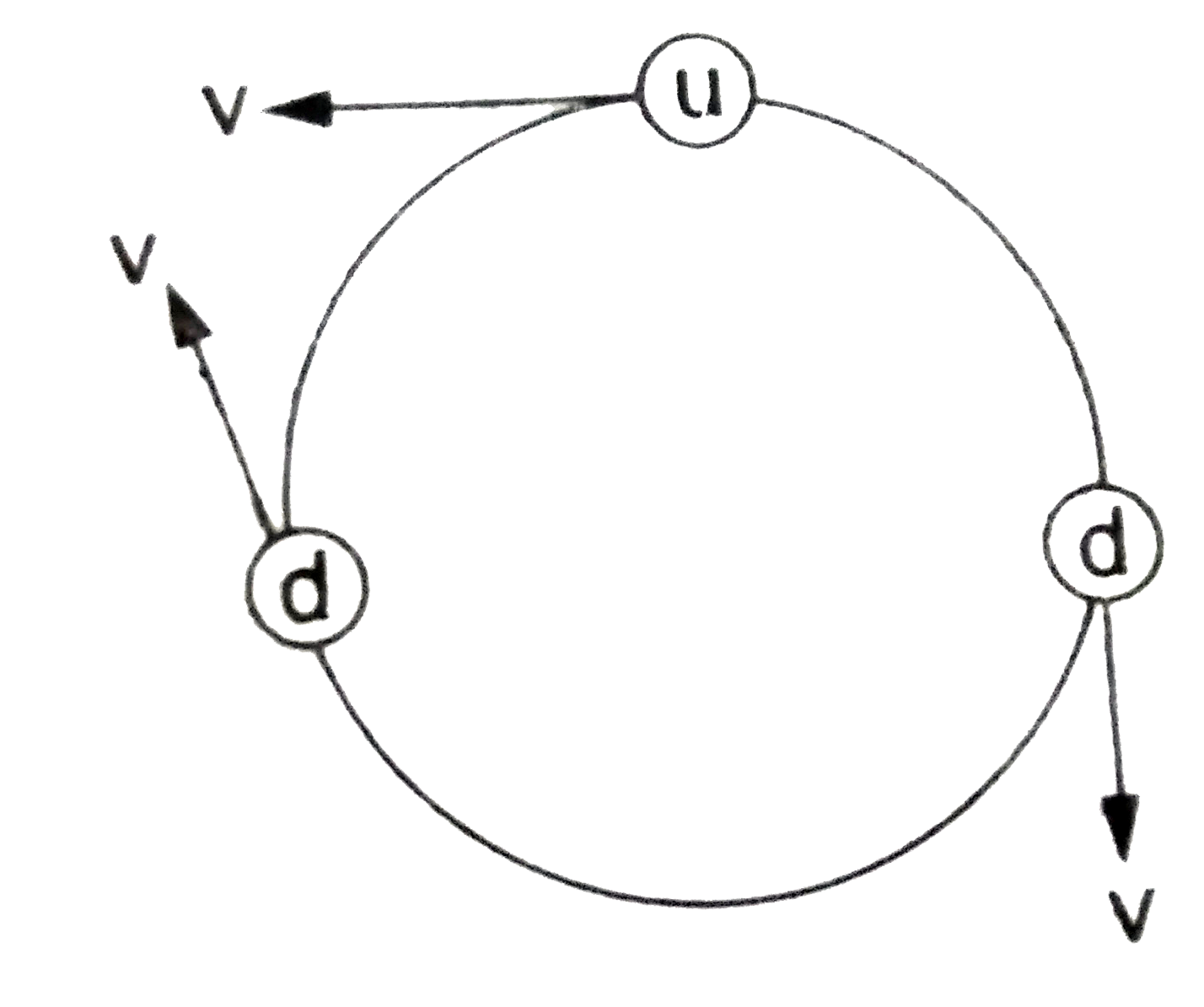
यदि क्वार्क मॉडल के तीनों क्वार्क समान दिशा में समान वृत्तीय गति उत्पन्न करें तब न्यूट्रॉन का नेट चुंबकीय आपूर्ण क्यो होगा ?
View Solutionनाभिक की संरचना प्रोटॉन तथा न्यूट्रॉन के कारण होती हैं , जहाँ प्रोटॉन धनावेशित कण हैं जबकि न्यूट्रॉन अनावेशित होता हैं । न्यूट्रॉन के क्वार्क मॉडल ( quark model ) के आधार पर इसका नेट आवेश शून्य रहने पर भी इसे अशून्य (nonzero) चुबंकीय आघूर्ण प्राप्त हैं जिसका z-घटक 9.66×10−27A−m2 होता हैं । इस संकल्पना की व्याख्या न्यूट्रॉन के आंतरिक बनावट के आधार पर की जा सकती हैं । न्यूट्रॉन की सरंचना तीन प्रकार के मौलिक कणों ( fundamental particles) व्दारा होती हैं जिन्हें क्वार्क (quark) कहा जाता हैंः
एक अप क्वार्क ( up quark ) , संकेत u , आवेश + 2e3
दो डाउन क्वार्क ( down quark ) , संकेत d , प्रत्येक पर आवेश - e3
तीन प्रकार के कणों के सम्मिलित प्रभाव से न्यूट्रॉन का नेट आवेश = 2e3−e3−e3 = शून्य । यदि ये क्वार्क गतिमान हो तब इनके व्दारा उत्पन्न चुंबकीय आघूर्ण अशून्य हो सकता हैं । चित्र में प्रदर्शित सरल मॉडल में u - क्वार्क r त्रिज्या v से वामावर्त दिशा में (anticlockwise) घूम रहा हैं तथा दोनों d - क्वार्क उसी वृतीय पथ पर समान वेग v से दक्षिणावर्त दिशा में (clockwise) घूम रहे हैं ।
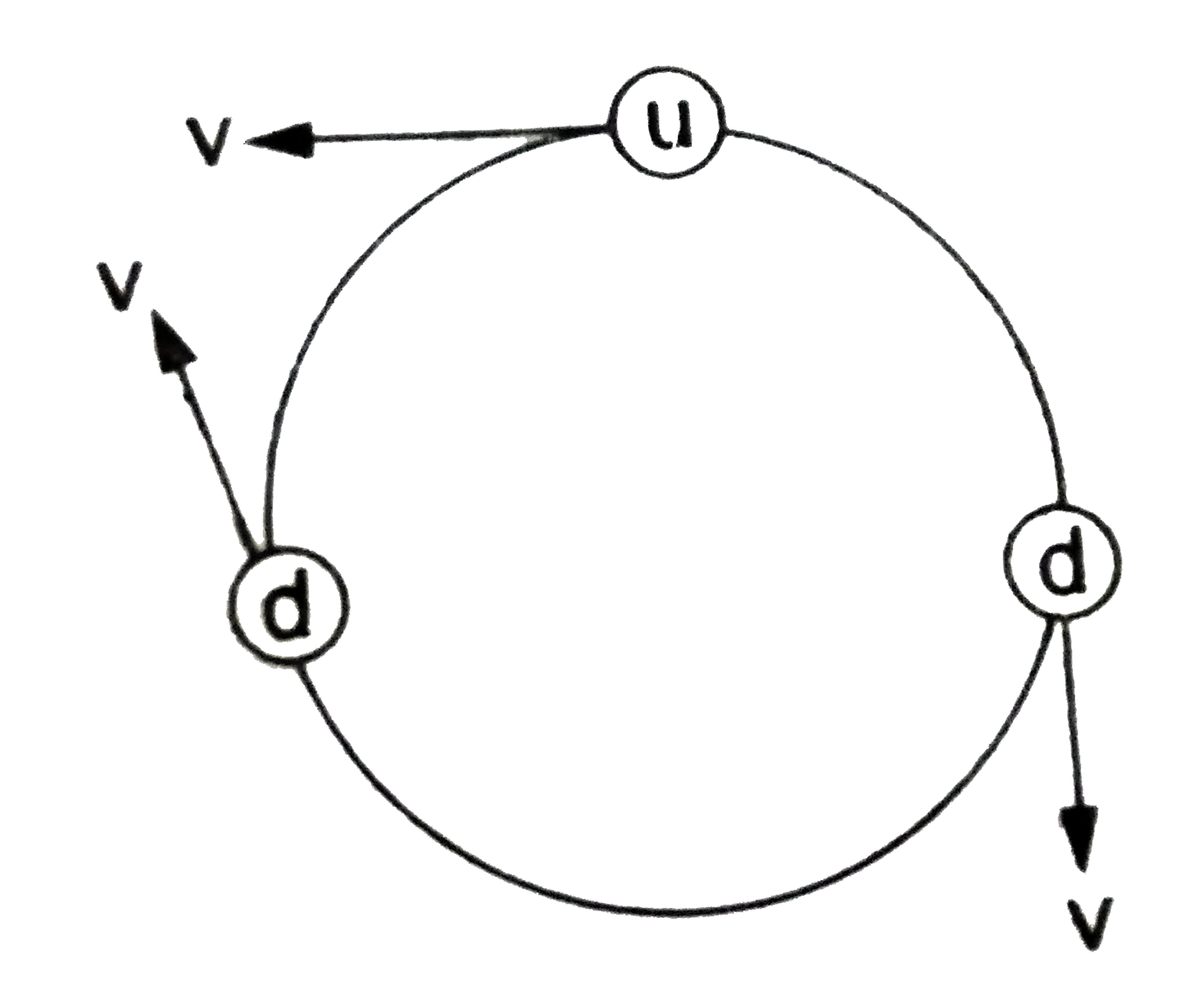
केवल एक d - क्वार्क की एकसमान वृत्तीय गति के कारण उत्पन्न चुंबकीय आपूर्ण का परिमाण
View Solutionनाभिक की संरचना प्रोटॉन तथा न्यूट्रॉन के कारण होती हैं , जहाँ प्रोटॉन धनावेशित कण हैं जबकि न्यूट्रॉन अनावेशित होता हैं । न्यूट्रॉन के क्वार्क मॉडल ( quark model ) के आधार पर इसका नेट आवेश शून्य रहने पर भी इसे अशून्य (nonzero) चुबंकीय आघूर्ण प्राप्त हैं जिसका z-घटक 9.66×10−27A−m2 होता हैं । इस संकल्पना की व्याख्या न्यूट्रॉन के आंतरिक बनावट के आधार पर की जा सकती हैं । न्यूट्रॉन की सरंचना तीन प्रकार के मौलिक कणों ( fundamental particles) व्दारा होती हैं जिन्हें क्वार्क (quark) कहा जाता हैंः
एक अप क्वार्क ( up quark ) , संकेत u , आवेश + 2e3
दो डाउन क्वार्क ( down quark ) , संकेत d , प्रत्येक पर आवेश - e3
तीन प्रकार के कणों के सम्मिलित प्रभाव से न्यूट्रॉन का नेट आवेश = 2e3−e3−e3 = शून्य । यदि ये क्वार्क गतिमान हो तब इनके व्दारा उत्पन्न चुंबकीय आघूर्ण अशून्य हो सकता हैं । चित्र में प्रदर्शित सरल मॉडल में u - क्वार्क r त्रिज्या v से वामावर्त दिशा में (anticlockwise) घूम रहा हैं तथा दोनों d - क्वार्क उसी वृतीय पथ पर समान वेग v से दक्षिणावर्त दिशा में (clockwise) घूम रहे हैं ।

केवल एक d - क्वार्क की एकसमान वृत्तीय गति के कारण उत्पन्न चुंबकीय आपूर्ण का परिमाण
View Solutionन्यूट्रॉन एक अनावेशित परंतु 9.66×10−27Am2 का z - अक्षीय चुंबकीय आघूर्ण (magnetic moment) रखनेवाला कण हैं । इसे न्यूट्रॉन के आंतरिक बनावट से समझा जा सकता हैं । प्रायोगिक सत्यापन से यह ज्ञात हुआ हैं कि एक न्यूट्रॉन तीन मूलभूत क्वार्क एक +23e आवेश के अप - क्वार्क (u) तथा दो −13e आवेश के डाउन - क्वार्क (d) से मिलकर बना हैं । तीनों क्वार्कों का युग्म इसे अनावेशित बनाता हैं । यदि ये क्वार्क गित में हो , तो एक चुंबकीय आघूर्ण उत्पन्न करते हैं । इस साधारण संरचना में यदि यह माना जाए कि u - क्वार्क घड़ी की दिशा की विपरीत दिशा में जबकि d - क्वार्क घड़ी की दिशा से r त्रिज्या वाले वृत्तीय पथ पर एक समरुप चाल v से चलते हैं , तो निम्नलिखित प्रश्नों के उत्तर दें ।
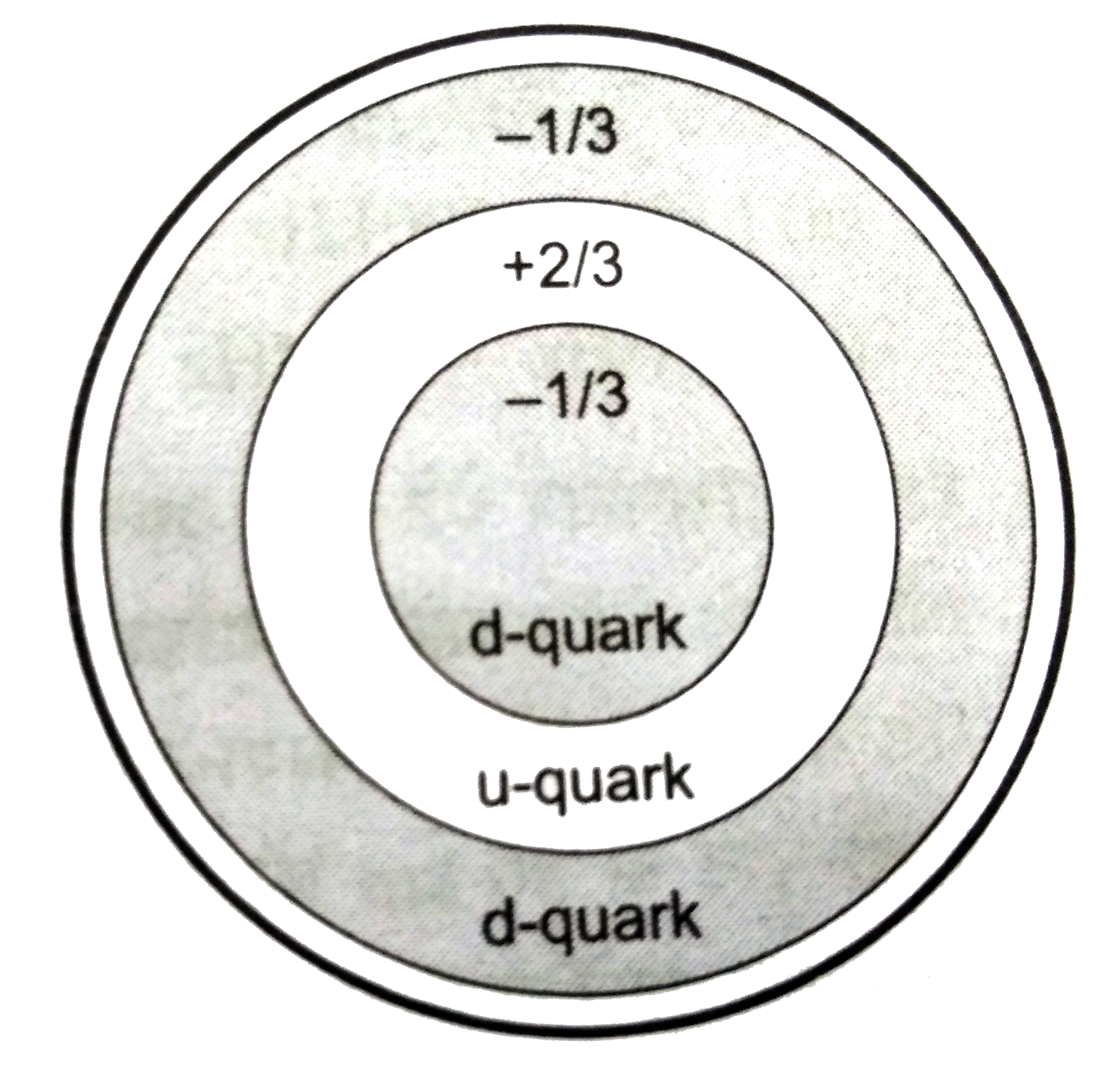
u - क्वार्क के घूमने के कारण उत्पन्न विद्युत -धारा का मान होगा
View Solution
